Nikon Coolpix P80 Review
Nikon Coolpix P80 Introduction
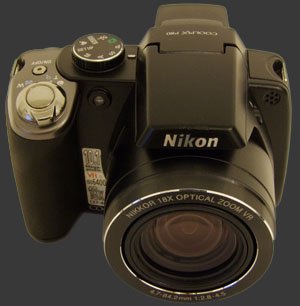 Nikon returns to the ultra-zoom prosumer digital camera market with the Coolpix P80, after 4 years of absence from this segment. This is always a difficult segment because of competition from low-cost DSLRs. To approach this, Nikon made the P80 as the smallest 18X optical zoom camera to date. Still, the P80 is aimed at more advanced users with its broad feature set:
Nikon returns to the ultra-zoom prosumer digital camera market with the Coolpix P80, after 4 years of absence from this segment. This is always a difficult segment because of competition from low-cost DSLRs. To approach this, Nikon made the P80 as the smallest 18X optical zoom camera to date. Still, the P80 is aimed at more advanced users with its broad feature set:
- 10 Megapixels sensor
- 18X Wide-angle optical zoom lens
- Optical image stabilization
- ISO 64-2000 at full-resolution
- ISO 3200-6400 at 3 megapixels
- Shutter speeds from 1/2000s to 8s
- Selectable dynamic range from 100% to 400%
- Full manual controls including manual focus
- Custom white-balance
- Exposure bracketing, 3 frames, 1/3, 2/3 or 1 EV increments
- High-quality movie recording
- Built-in distortion correction
Nikon Coolpix P80 Suitability - What is it good for?
The Nikon Coolpix P80 is highly versatile due to its 18X optical zoom which starts at a wide-angle 27mm and reaches 486mm, in 35mm equivalent terms. This wide range covers most photographic uses, particularly well in the telephoto range for wildlife and bird photography. Macro photography is also possible with the Nikon P80 which can focus as close as 1cm (0.4").
The P80 also features full-manual controls for creative and versatile exposures. With a shutter-speed range from 1/2000 to 8s, the Nikon Coolpix P80 can handle action and night photography.
The selling point of the P80, to distinguish itself from other 18X (and some 20X) optical zoom cameras is its compact size. At barely 3" deep, with a similar height, it is easy to take places, provided it has a small pouch or large coat pocket for storage. It will probably fit easily in a purse as well. Size is key to versatility as it enables more photo opportunities simply because a smaller camera gets taken to more places.
With a 10 megapixels sensor, images from the Coolpix P80 are suitable for relatively large prints, up to 20"x15" provided ISO is kept low. More details on this follows. Needless to say, any computer display or web-use will not be a problem.
Storage and power options for this digital camera are rather typical of ultra-zooms. The P80 supports SD-HC cards which always means SD too. The Coolpix P80 is powered by a small proprietary lithium-ion battery.
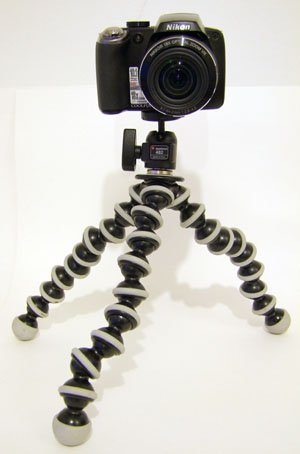
Nikon Coolpix P80 Capability - What can it do?
As an ultra-zoom, most of the flexibility comes from the P80's huge zoom range. Like most ultra-zooms, this digital camera is equipped with a number of advanced features. Below is a list of its most useful features, followed by explanations, when required.
- White-balance: Auto, 5 preset and custom.
- Program with shift, shutter-priority, aperture priority and manual exposure.
- Metering modes: matrix, center-weighed, center spot and AF-point spot.
- Exposure compensation: +2 to -2 EV, in 1/3 stop increments.
- Exposure bracket: 3 shots, 1/3, 2/3 or 1 EV steps.
- Multiple Auto ISO ranges: 64-100, 64-200, 64-400 and High
- Flash: Auto, red-eye, off, on, slow-sync and burst.
- Focus: Normal auto focus, macro, infinity and manual.
- Drive: Single-shot, continuous, BSS, multi-shot 16, interval timer.
- Custom image parameters: 5 contrast and sharpness settings, 3 saturation settings.
- Optional noise-reduction.
- Optional distortion compensation.
- Optional vibration reduction.
A few features here appear in other Coolpix cameras but may not be familiar to everyone. BSS is best-shot-selector which is a drive mode which takes a few shots in rapid succession and stores the least blurry one. An other drive mode is Multishot-16. This mode records 16 ultra-low resolution photographs into a single low resolution image. Distortion compensation triggers processing in the camera to compensate for optical distortion inherent in the lens.
In addition to normal and macro focus present in most digital cameras, the P80 has a manual focus mode and infinity one as well. In macro mode, the center of the image can be magnified to closely inspect focus. In infinity mode, focus is locked at infinity. This is useful for photography at night and from moving vehicles where the camera cannot possibly focus.
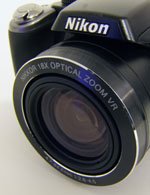 The Nikkor 18X optical zoom lens of the Nikon Coolpix P80 has a wide range from 27mm to 486mm in 35mm terms. This is 1mm wider than what is considered wide-angle and reaches well into the telephoto range used for wildlife photography and birding. The exact same range is found on some recent ultra-zoom digital cameras from Fuji and Olympus, although since then Olympus has moved on to even wider 20X optical zoom which goes from 26mm to 520mm. Panasonic and Canon start their latest ultra-zoom lenses at 28mm. All in all, we appreciate the trend of wider angle lenses on recent cameras, particularly relatively compact models like this one.
The Nikkor 18X optical zoom lens of the Nikon Coolpix P80 has a wide range from 27mm to 486mm in 35mm terms. This is 1mm wider than what is considered wide-angle and reaches well into the telephoto range used for wildlife photography and birding. The exact same range is found on some recent ultra-zoom digital cameras from Fuji and Olympus, although since then Olympus has moved on to even wider 20X optical zoom which goes from 26mm to 520mm. Panasonic and Canon start their latest ultra-zoom lenses at 28mm. All in all, we appreciate the trend of wider angle lenses on recent cameras, particularly relatively compact models like this one.
Vibration Reduction is Nikon's image stabilization. The Nikon Coolpix P80 is equipped with stabilization which compensates for involuntary camera movements, up to 3 stops compared to no stabilization. This helps with the usability of such a long zoom. Recall that the rule-of-thumb is to shoot at 1 over the focal-length. So, at the 486mm end, shooting at 1/500s is expected for shots to come out sharp. Considering a somewhat small maximum aperture at 486mm and the desire to use low ISO settings, achieving 1/500s can be difficult. With stabilization, this requirements is reduced to 1/125s or even 1/60s.
Nikon Coolpix P80 Usability - How easy is it to use?
The Nikon Coolpix P80 is relatively strait forward to handle and operate. Its light-weight body is well built and features a good hand-grip despite being small overall.
The main controls are easy to use with positive click points. The shutter-release is good. It has a distinct halfway point used to focus the camera before taking a picture. The P80 has a single command dial which is set on the camera's rear within easy reach of your thumb. While it is well-placed, it is too recessed to comfortably operate the camera with gloves on.
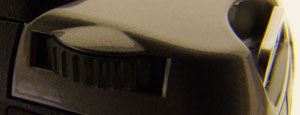
The tethered lens-cap easily stays with the camera but causes a lens-error when it is powered on with it in place. Underneath the P80, a metal tripod mount is placed at the camera's physical center. It is better for panoramas if the tripod mount is aligned with the lens' center but for other uses the physical center gives more balance.
The P80 is powered on by a simple button on top of the camera, behind the shutter-release. The zoom controller is wrapped around the shutter. Zooming is quite fast if a little coarse for such a range. The top of the camera also holds the mode dial. It features the usual Auto, Program, Aperture-Priority, Shutter-priority, Manual and Movie mode. Additionally it has Setup, Scene and High-Speed shooting positions. The Setup scene is a mode dedicated to the setup menu, photographs cannot be taken in this mode. The Scene mode hides all individual scene modes under one setting. The only thing better than using a single dial position for Scene modes is not having any. High-speed mode is a 3 megapixels but quite fast continuous drive mode which works in together with continuous auto-focus.
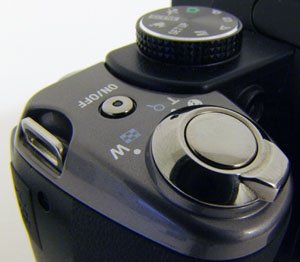
As most ultra-zooms, this digital cameras features a large rear LCD and a small EVF. The EVF is possibly the P80's biggest problem. Its protruding position is very goo. However, the miniature LCD itself is always too dark and its brightness cannot be adjusted. It is also quite coarse. Together this means that the EVF is unusable quite often. The LCD is somewhat better with great visibility but limited dynamic range: what you see as all-white or all-black on the LCD may not be over or under-exposed, but you just can't tell by looking at the review image. The position of the LCD, which is flush with the camera's left side, is also not ideal as it gets nose marks quite often there. Another problem with the LCD is that the preview isn't entirely accurate, although not by much. In Auto and P mode, the LCD is exposure-priority but not in M mode and not in Aperture-priority or Shutter-priority mode when parameters are out of range. This is really too bad as you do not see visually the effects of being beyond the camera's exposure range.
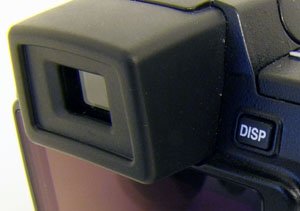
The camera has a button to switch between the EVF and LCD which is separate from the display mode button. The display mode button cycles through the image-only, information and alignment grip modes. Speaking about the displays, both of them have poor coverage, showing only 97% of the frame.
On the camera's rear, a standard 4-way controller is used to navigate menus and as short-cut to some camera functions. Those functions are: flash-mode, self-timer, exposure-compensation and focus mode. Unfortunately, ISO, white-balance and drive mode do not have dedicated buttons and therefore must be changed by using the menu system. The menus are easy to navigate, plus having a setup menu mode alleviates the shooting and playback ones from being too long. This camera is shooting-priority except in Setup mode. The playback button toggles playback mode and the shutter-release returns the camera to shooting mode. The user interface has plenty of useful and intuitive indicators to remind users of how to operate the camera. There is also a delete button which prompts for deletion of the last image shot when in shooting mode. In playback mode, the delete button prompts for deletion of the displayed image.
ISO is selectable between 64 and 6400. Up to 2000, the camera can shoot at its maximum resolution of 10 megapixels. From 3200 onwards, the P80 limits itself to 3 megapixels which is normally enough for an 8"x10" print and for displaying full-screen on most computer displays. Because the usable ISO range depends on the photographic medium, it is great when a camera like the P80 allows the Auto ISO range to be selected. The P80 offers 4 possible ranges: 64-100, 64-200, 64-400 and 64-800 (labeled as High).
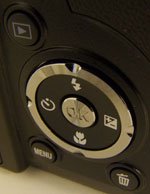 The Nikon Coolpix P80 allows shutter-speeds to be selected in full-stops only, while aperture values can be chosen in 1/3 stops. This makes program-shift behave quite strangely because the shutter-speed does not change unless the
aperture is changed by enough to require a full-stop difference in shutter-speed. It is hard to image what would call for such a limitation.
The Nikon Coolpix P80 allows shutter-speeds to be selected in full-stops only, while aperture values can be chosen in 1/3 stops. This makes program-shift behave quite strangely because the shutter-speed does not change unless the
aperture is changed by enough to require a full-stop difference in shutter-speed. It is hard to image what would call for such a limitation.
This ultra-zoom allows for -2 to +2 stops of exposure compensation and flash compensation, both in 1/3 stop increments. Exposure bracketing, always 3 frames, can be set in increments of 1/3, 2/3 or 1 EVs. One annoyance with the P80 is that file-numbers do not reset after formatting a card, they just keep going which annoys the hell out of camera reviewers. We are not sure if others care about this though.
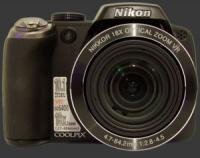 |
Please Support Neocamera
All information on Neocamera is provided free of charge yet running this website is a huge endeavor. Purchases made via affiliate links found throughout the site help keep it running and up-to-date. There is no additional cost to you, so please consider buying via these links to our affilates:
If you found any information on this site valuable and did not purchase via our affiliate links, please considering donating via PayPal:
Any amount will be greatly appreaciated. Thank you for your support!
Nikon P80 Highlights

Sensor-Size: 6 x 5mm
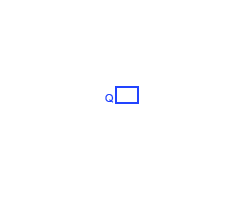
Actual size when viewed at 100 DPI
| 10 Megapixels Ultra Zoom | ISO 64-2000 |
| 18X Wide Optical Zoom | Shutter 1/2000-8s |
| Built-in Stabilization | Full manual controls |
| 0.24" Built-in EVF 230K Pixels | Custom white-balance |
| 0.8 FPS Drive, 4 Images | Spot-Metering |
| 640x480 @ 30 FPS Video Recording | Lithium-Ion Battery |
| 2.7" LCD 230K Pixels | Secure Digital High Capacity |
Updates
2024.04.03

Fujifilm X-T5 Review
Newest Fujifilm flagship boasting a 40 MP APS-C sensor, 5-axis IBIS with 7-stop efficiency, 15 FPS continuous drive, 6.2K Video capture, dual control-dials and dual SDXC UHS-II slots in a sturdy weatherproof and freezeproof body.
2023.11.20

Best Digital Cameras of 2023
Find out which are the Best Digital Cameras of 2023. All the new Mirrorless Digital Cameras from entry-level to high-end professional.
2023.07.10

Fujifilm X-H2 Review
40 Megapixels APS-C Hybrid Mirrorless Digital Camera with 7-stop IBIS. Fastest shutter ever and 8K video capture. Large builtin EVF with 0.8X magnification and 5.8 MP, plus an Eye-Start Sensor. Packed with features and large number of controls in a weatherproof and freezeproof body.
2023.05.07

Sony FE 20-70mm F/4G Review
Review of the unique Sony FE 20-70mm F/4G lens. The optical zoom of this lens spans ultra-wide-angle and medium focal-length coverage, making it one of the most versatile Full-Frame lenses on the market.
2023.01.15

Huion Inspiroy Dial 2 Review
Review of the Huion Inspiroy Dial 2 tablet, a medium sized drawing surface with dual dials and customizable buttons. Connects via USB-C or Bluetooth 5.0 with Windows, Linux and Android support.
2022.12.08

How to Pack for a Photo Trip
Find out how to pack for a travel photography trip, carry your gear safely while meeting airline regulations.
2022.11.13

Best Digital Cameras of 2022
The best digital cameras of 2022. A short list of the most outstanding models in their respective categories. Choose one for yourself or as a gift.
2022.09.21

Pentax DA* 60-250mm F/4 SDM Review
Review of the Pentax DA* 60-250mm F/4 SDM, the constant-aperture telephoto zoom with the highest zoom-ratio on the market.
2022.09.20

Pentax DA* 50-135mm F/2.8 SDM Review
Review of the Pentax DA* 50-135mm F/2.8 SDM, the lightest professional telephoto zoom native to the K-mount.
2022.09.10

Pentax DA* 11-18mm F/2.8 DC AW Review
Review of the Pentax DA* 11-18mm F/2.8 DC AW, the widest professional ultra-wide zoom native to the K-mount.
2021.11.24

50 Gifts Under $50 For Photographers in 2021
50 Gifts photographers will love. All for under $50 USD. 2021 Edition.
2021.11.17

Best Digital Cameras for 2021
Neocamera shows which are the very best Digital Cameras for 2021 in every category: Mirrorless, DSLR, Premium Compact, Ultra-Zoom and Rugged.










